In a fuel-sipping station wagon bought just for the purpose, I chart a course westward.
With few maps or plans, not hurried but on a schedule nonetheless, I took a northerly route through as many parks and small roads as I could manage.
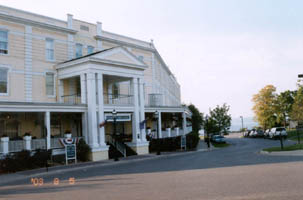
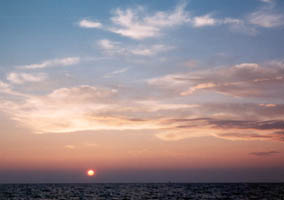
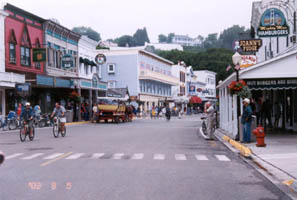
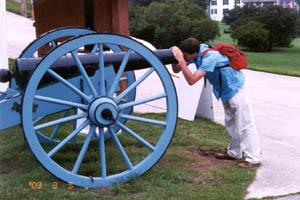
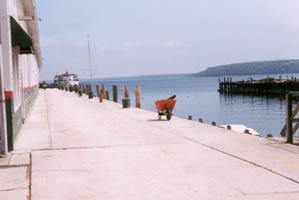
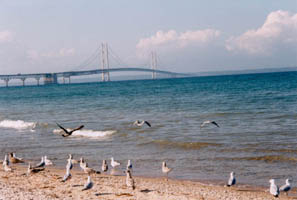
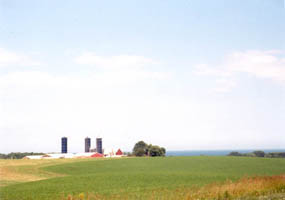
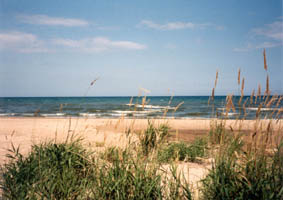
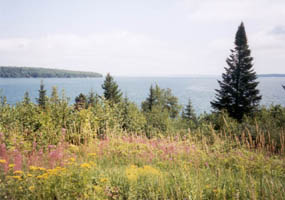
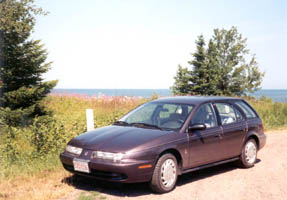
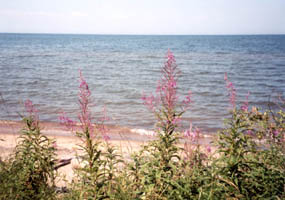
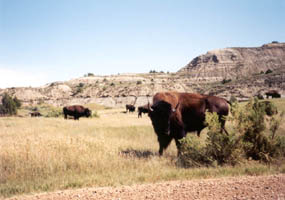
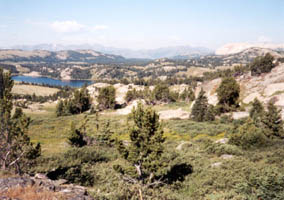
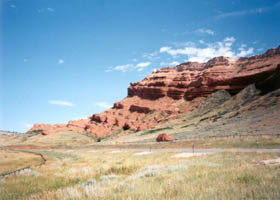
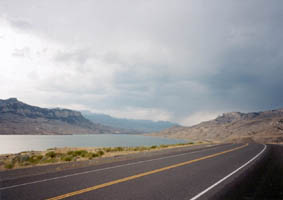
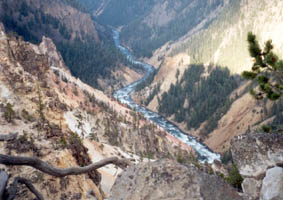
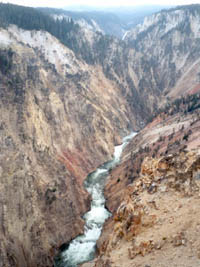
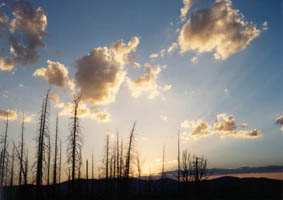
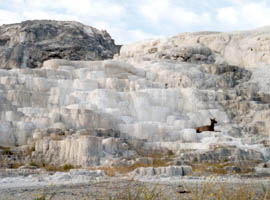
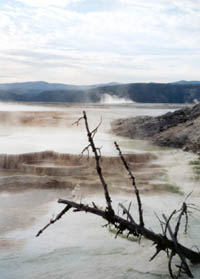
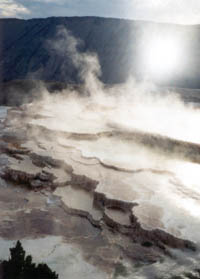
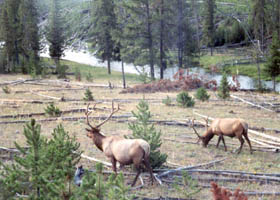
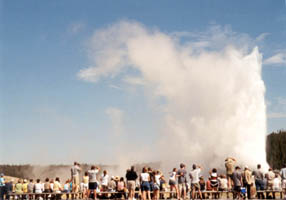
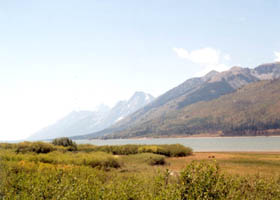
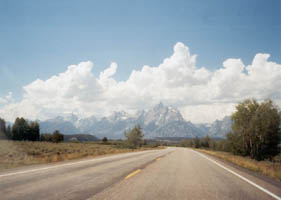
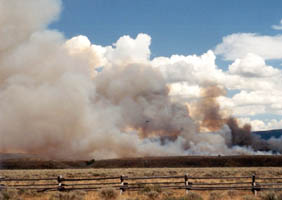
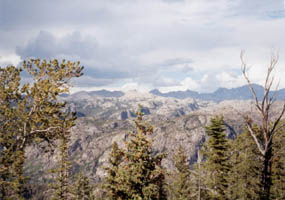
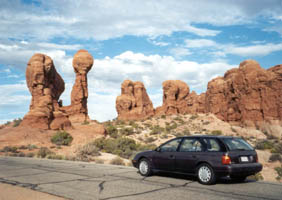
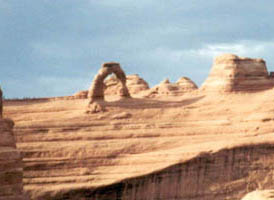
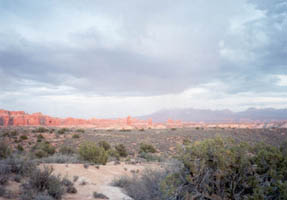
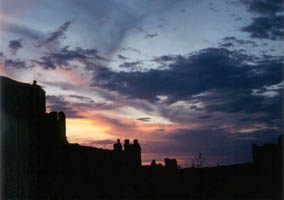
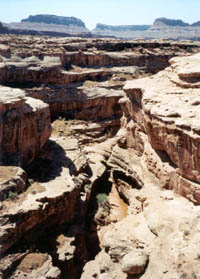
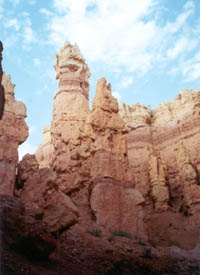
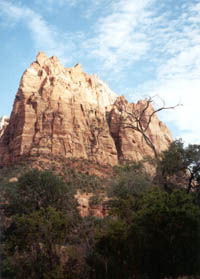
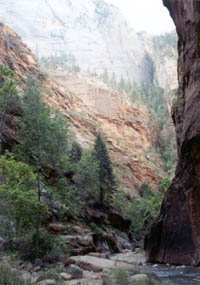
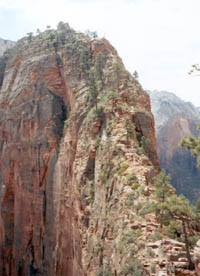
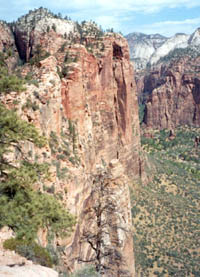
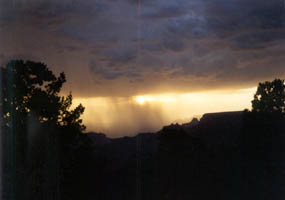
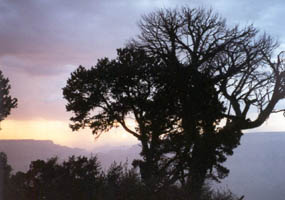
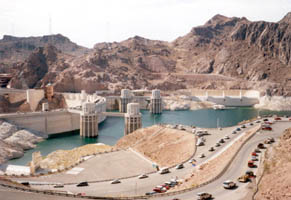
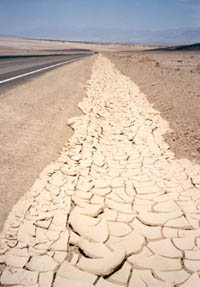
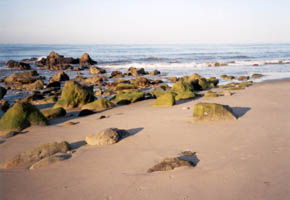
Three thousand miles away across great forests and deserts a job awaited, offered up from the depths of a short but deep economic recession by my superb summer employer, NASA's Jet Propulsion Lab. Out there on the far side of the continent hot summer sun beat down on California orange groves and huge Pacific waves pounded the golden sand where beautiful people play volleyball and carry surfboards. I had four weeks to get there, find a place to live, and get settled. College graduation was two months passed, my things were packed and sent along in a moving van, and I had just bought an old Saturn station wagon for a leisurely drive out west.
Everything was ready with one notable exception: I wasn't exactly longing for another meandering journey. For seven of the previous ten weeks, I had drifted around a narrow swath of South America living on street food and sitting in city plazas watching people and time pass. At least in the US I would be in familiar surroundings, and I would have a car to take me anywhere I felt like going. The Saturn was good with gas, with a manual transmission and seats that folded back so I could sleep in the car. However all the boxes and bags of things that accompanied me were sure to attract attention so I couldn't leave them and go off overnight through the mountains. Other than that, I could go anywhere I pleased as long as it took me generally westward.
Friday, August 1st began with heavy rain at dawn. I had difficulty walking from the house to my car without becoming entirely soaked, even with an umbrella. It was a strange feeling to be setting out on a trip from which I had no plans to ever return. For twenty-two years I had called my parents home my own and now I was moving out for real - this wasn't a summer job or a semester at school. The rain persisted through the morning as I drove into southern New York on the familiar path to Rensselaer and then veered south on I88. Rolling hills flattened as I neared the south shore of Lake Ontario and eventually disappeared as I crossed Pennsylvania and the urban expanse of Ohio. There was traffic near Cleveland and Toledo and the entire route was enveloped in hazy gray industrial suburbs. Heavy thunderstorms loomed to the West as I turned northward to Detroit and passed through some impressive downpours. At dusk I arrived in Farmington Hills for a visit with Erin and her family, having crossed an impressive distance for one day's travel.
After a couple days staying in town, on Monday morning we drove north all the way to the tip of the Michigan mitt. We bought perfectly ripe cherries and ate them in the car while driving to Petoskey, where we found a room in the center of town at a beautiful old hotel. The shops had closed surprisingly early. After dinner at an Italian cafe we watched a lovely sunset on the lake from the breakwater. Sailboats sped back and forth as the sun, an orange ball, sank into the haze.
Morning found us on our way to Mackinaw, where we ate breakfast and hopped on a ferry to Mackinac Island. Devoid of cars but full of horses and bicycles, the strategic island has restored British forts and historic buildings scattered among restaurants and fudge shops. The famous fudge comes in dozens of flavors and is made in a big copper pot, then poured onto a 6-foot long marble slab table to cool in a long loaf that is sliced like bread. Many shops compete with similar prices and flavors but we sampled them all and found a superior vendor.
The morning was misty but midday it became clear and sunny. We browsed the shops and lounged on benches by the harbor to watch the boats come and go. Colorful lines of people crowded the dock where the ferries arrived. Late in the afternoon we returned to the mainland, explored the quaint shops of Mackinaw, and headed back to Petoskey where we watched another sunset while searching the rocky shore for a fossilized coral called "Petoskey stone." We found many shell fossils and some trilobites, and finally some Petoskey coral embedded in a large boulder. I found a smaller rock with several coral inclusions and we hauled the heap we had collected up to the road. I brought the car down and we loaded it in. Dinner was late but we found a restaurant that was still open.
Wednesday we shopped for souvenirs at a rock shop and drove to Charlevoix for breakfast at the popular Julierettes, home of hearty but overpriced breads. The drive back south was long and we simply ran out of time to do all the things we'd hoped to. We stopped for dinner at a huge mall and ate at the Rainforest Cafe, an elaborate and overwhelming restaurant decorated to look like a junge, complete with mechanical animals, rain, lightning, tunder, and birdcalls. The food was good, and the setting entertaining though I couldn't figure out how such excess could be justified given their mission to promote conservation.
In the morning I had my first experience with an an automated carwash, lured in by a coupon. I drove into a dark tunnel onto a track that seized my car and began to pull it toward the gaping maw of the washer. People with powerful water guns came at me and then great wet mops slapped at the car. It rocked from side to side and the radio antenna was beaten in every direction. Next a fleet of ducted blower fans sounding like jet engines blasted the windshield and shook the wipers. Then I was released and a man with a towel wiped down the car. Everything seemed well except my rear wiper stopped working - maybe there was no connection to the car wash, but I don't know for sure.
Continuing west, I decided to drive to Chicago and then north rather than repeat the drive north across Michigan. Chicago was a terrifying hazy city with too much traffic - it was my misfortune to arrive during rush hour. Milwaukee, though, was a beautiful city on the azure blue waters of the lake. North of Milwaukee I drove over gentle green terrain beside the blue lake. The farms and fields and forest were very beautiful, splashes of color in neat order with an air of peacefulness. Once I took a road to where it stopped at the shore and lingered for a while watching the waves tumble in. The water was so very blue over the light colored sand and the grass was brilliant green and the wave crests were sparkling white. I felt very much a guest in a place that I'd be happy to call home, but my destination was still far away. Driving on I passed mile after mile into distinctly Northern forest. At dark I stopped in Minocqua, a nice resort town on a lake, and got a room near the center of town.
In the morning I stayed until some shops opened to have a look around. Then it was time to move so North I went, to the shore of Lake Superior. For some reason I always felt in a hurry. There was an urgency to move, a need to keep searching as if I knew the elusive thing I sought would not be found at the present location. I passed through quaint little towns on the shore and then explored the Apostle Islands Coast before heading West and finding a much more beautiful coastline along the main road. The horizon was blue water, the shore sandy and strewn with driftwood and boulders, and the bank free from development and covered in grasses and wildflowers. It was the sort of place I would have enjoyed for hours had I been traveling with someone, but after a few minutes of resting in the sunshine I continued on to the port of Superior/Duluth where great ore-shipping infrastructure towered beside elegant arched bridges and green bluffs dotted with buildings. Hills of ore stood among concrete towers and church steeples poked above the green foliage in town. I would have liked to stay a while but in a flash of pavement and guardrails the view behind me was gone. I left the forest and entered hay country, then wheat country. Minnesota passed by and I was in North Dakota, where the wheat was ready to harvest and fleets of combines prowled across the fields in formation leaving trails of dust. The evening air smelled of cut plants and insects splattered upon my windshield so heavily that once I thought it was raining. Every so often I passed an ancient harvesting machine set on a hilltop, looking like a lumbering dinosaur.
As darkness fell the combines came in from the fields, creeping home along dark roads with flashing lights marking their wide jaws, looking weary from a long day's work. Soon after dark I stopped, sleepy and wanting to see by day the country I drove through. Also I dislike driving at night when I can't see the road as well. Fearing a rapidly draining bank account, I slept in the passenger seat in a hotel parking lot. It was quiet and safe and unlike most parking lots, no one thought it odd that my car would be parked there overnight. The Saturn's seats were very comfortable too with a big pillow and blanket. Transition through the timezones came easily for me, because it allowed me to stay up late, sleep late, and still be on my way early by the clock. However, no restaurants were open when I wandered out seeking breakfast! Hungry, I bought fruit and bread and granola bars at a supermarket. Before sunrise I woke and was on my way, crossing North Dakota to the Badlands (Theodore Roosevelt National Park, South Unit) by late morning. Only in the parks did bison roam free and prairie dogs nibble grass while their sentries stood tall on mounds and whistled the all's-well call. At the park I bought a $50 annual park pass good for all the national parks for the coming year. The Badlands aren't bad at all, except for farming. The rugged red and brown hills are covered in shrubs and grasses and home to bison and prairie dogs, among other wildlife. I hadn't seen either before. Apparently underground coal seams set afire by burning grass smolder for many years and bake the surrounding clays to create the red tones. No seams are burning now but one last smoked in 1971.
North Dakota sunflowers and corn and wheat were replaced by hay fields as the hills became more rugged. I drove into the Mountain Time zone in Montana. There were more hayfields and hills that could be mountains. In Billings I decided to stop for the night at a cheap motel, but I had to get a smoker room since ther was a fair in town and roomes were scarce. It was unpleasant, but I had a good shower. The setting sun was spectacular, huge and red in a hazy sky that turned many shades of magenta and gold before fading to gray.
I left Billings at sunrise and drove to Red Cloud, leaving I94 behind me and instead taking a narrow winding road up into the mountains to a pass just below 11,000 feet. There was snow, rock, tundra, and little else on the high plateau. I descended to Cody, Wyoming, for lunch. The tourist town is home to many craft shops and restaurants though many were closed on Sunday. I treated myself to a sandwich and ice cream at a deli and browsed the disappointingly small Sierra Trading Post outlet store before the press of vacationing families began to bother me and prod me onward. I stopped at the Buffalo Bill dam to peer over the precipitous edge where the dam blocked a narrow canyon, and then drove into Yellowstone Park. There were steaming, stinking, boiling mud puddles and large herds of bison, but most spectacular was the canyon. A turquoise ribbon of rushing water wound its way through a great yellow gash in the forest, very deep, with red and white and rust and orange streaks and layers of rock dotted with conifers and scattered steam vents. The falls at the head of the canyon were impressive and flowing heavily even in mid-summer. The vista was exactly like I'd imagined it to be ever since I saw an image of a painting by Thomas Moran, "The Grand Canyon of the Yellowstone," when I was 10 or 12 years old. I toured all the scenic overlooks before moving on late in the afternoon to find a place to sleep. I drove into the hills and pulled aside at a lonely, windy turnout to sit on a boulder and think for a while.
I realized that the sun would set on a nearby ridge, so most of the color would be hidden if I stayed where I was. Instead I continued on and drove to a high overlook on the road to a fire tower. There, among stands of dead trees burned by the 1988 fires, I watched a lovely sunset and the rise of the full moon. I considered staying for the night but a park patrol car came through and I figured they would make a sweep after dark and then close the gate at the bottom of the road. Instead I drove to Tower Junction and selected a quiet parking space beside guest cabins for another night in the car.
At dawn I continued my tour of Yellowstone. The terraced hot springs were beautiful and I was lucky to see a mule deer bedded down on a terrace of dry springs, surrounded by crystalline white cascades. The other attractions in the park became tiring though. I stopped to watch some of the geysers, including Old Faithful. That geyser is such an attraction that infrastructure exists to support thousands of visitors. There are lodges, pathways, a large observation area, huge parking lots, and even a highway interchange on the park road nearby to handle the traffic that departs in waves every 65 to 90 minutes. After the geyser erupted I hurried out of Yellowstone and into the Grand Teton National Park, where great spikes of granite soar skyward beside a bright blue lake. The peaks were steep, craggy, snowy, and surprisingly few in number so and I soon passed them. Again I felt hurried, for no reason since I had weeks left before I'd begin work. The call of everything still unseen pulled me on. The town of Jackson was another tourist destination, full of people I'd like to meet but would never see again. That's the trouble with traveling - one can make many friends, but will almost certainly lose them all. I drove past a grass fire and stopped to watch. A ranger also in the rest lot said it had been started the day before by lightning, burned south, turned back north when the wind changed, and now was flaring up because of increased winds. Ground crews were moving in and a helicopter arrived to drop water. I was surprised by how tiny the helicopter was compared to the fire - just a bumblebee with a thimblefull of water to fight a huge cloud of smoke and heat and flickering flames. Later that day after I passed, the wind shifted and smoke closed the highway for several hours.
The road south went into desolate, empty, windy country with rugged mountains rearing up to the east. On my map I could find no roads into the Wind River Range and indeed they are very inaccessible. The nearest towns had 200 or 300 people and from a trailhead it would still be a long day's hike to a base camp for any climbs of the higher peaks. That part of Wyoming was so empty that it made me sad. I would have loved to trek into those granite hills with a friend and food for a week. I sat on a breezy overlook and ate very sweet wild raspberries and peered at the jumbled canyons and peaks through my binoculars. I vowed to return, and two years later I did - brought back for a friend's wedding, I had time to hike into the mountains for a night beside a little lake where I watched a spectacular meteor shower.
At dusk I was in Rock Springs, a rest stop on I80 where I spent the night. Dawn came just in time; it had been a restless night for me that started hot and ended cold. With a few more filler pillows, though, my accommodations could be very comfortable. I got right on the road to Utah, chugging along I80 for about 10 miles before retreating to lonely roads where I could cruise along at a fuel-sipping 50 mph while seeing only a handful of vehicles an hour. Along the road geological signs identified formations. Flaming Gorge dam appeared to have drowned the flaming gorge, but some colorful rocky bluffs protruded above the water. I stopped at Dinosaur National Monument to see the fossil quarry and get a little more out of my Parks Pass. I drove a short way into Colorado for a scenic drive south through the hills, then stopped at Colorado National Monument. I had no idea what to expect there and was surprised to see rugged red sandstone canyons and beautiful rock formations. I'd always thought of Colorado as granite peaks, but of course the western edge is much like Utah.
Returning to Utah, I took a very scenic road alongside the Colorado River through a canyon to Moab. There were red sandstone towers, cliffs, and hills hugging close to the green river. In Moab I bought an overpriced roll of film and headed into Arches National Park to see what I didn't two years earlier. This time broken clouds made for varied photography and with more time to spend in the park I saw more arches and explored more footpaths. At sunset I watched the colors dance among the sandstone towers, the western horizon flame to deep red, and a rainbow hang from the clouds in the wisps of virga. Back in town at dark I chose a hotel that offered free breakfast. There are so many hotels in Moab that competition drives down prices to what I was paying in the middle of the Montana plains, even though it's a tourist town.
Utah was not a happy place to travel that year. I drove all day on winding roads in heat and sun with bad food and no one to talk to and nothing exciting to see. I stopped at Natural Bridges National Monument, Canyonlands National Park, Capitol Reef National Park, Grand Staircase Escalante National Monument, and many more national rereation areas and scenic vistas. At sunset I was at Bryce Canyon for the second time in my life; it hadn't changed. I walked down among the hoodoos and snapped some photos, then drove to an overlook to the west and watched the sun set. Dinner was another disappointment of overcooked spaghetti. I couldn't find a place to sleep either, settling for a turnout on a dirt road.
In the morning it was so cold I turned the heat on for 10 minutes before trying to do anything else. I set out for Zion National Park and arrived at 8am when the air was still quite cool and the parking lots not yet full. There was no guard at th entrance and cars were driving through so I followed, hoping they'd check passes upon exit. They didn't, and though I have a park pass I still felt guilty. Immediately I took the shuttle bus to the bottom of the Narrows and waded up for a half-mile, rolling up my pants to keep them dry. The canyon was beautiful and peaceful and deserved a second visit; I went back in 2008 to see more of the park. After I turned around I met dozens of people splashing up, the first wave of the day's crowds. Next I took the shuttle to the Angels' Rest trailhead and set out wearing my flip-flops and carrying my camera and half a liter of water. People descending eyed my footwear critically but most of the trail was a paved sidewalk snaking its way 600 feet up the steep canyon wall. The next 400 feet were atop a narrow sandstone fin jutting out into the valley, with chain handguides and steps cut into the red sandstone. Climbing was easy but very exposed. I'd never before walked on such a knife edge where I could hold two stones in outstretched arms, drop them at once, and have each fall to the bottom of its respective side many hundreds of feet below. The view from the top was lovely but I had only enough water to hurry down, so that I did - carefully, because descending is always harder than climbing, especially wearing flip-flops. I refilled my water bottles and left the crowds behind. After Zion there was little to see through the rest of Utah and northern Arizona. Arizona was hot and empty. I wanted to make the Grand Canyon by sunset so I hurried along.
I was discouraged to see storms moving in, which I supposed would obscure the sunset, but the lightning show and curtains of rain were very impressive. The storms were moving away from me so I began driving over wet pavement from the scattered showers accompanying the storms. Farther on I passed two trees on fire, flaming and smoking a few hundred yards apart and perhaps 200 yards from the road. It was an odd sight, something I'd never seen before but probably quite common in the west where dry thunderstorms are frequent. I climbed through forested hills as the storm became more intense, with short bursts of wind and rain battering my car. At the park gate the ticket booth was closed and a guard in the building nearby waved me though. But, I had a pass and wanted to use it! Suddenly I was at an airy point and the sun was setting through a gap in the clouds at the western horizon. A great canyon dropped away below me, mist rolled over the rim and clouds swirled overhead, and intense lightning flashed all around. I was very uncomfortable sitting atop the highest point of land in such a storm, but I darted out to take a few photos of the red sun behind sandstone towers and canyon crags with clouds overhead before racing back to the relative safety of my car. I couldn't capture the lightning bolts streaking across the sky and shooting past the setting sun, or the hailstones and the heavy raindrops and the downpours and the wind that rocked the car. As darkness fell I retreated to the road along the canyon rim and drove into a terrifying tunnel of darkness, split by tremendous flashes that hurt my eyes and sometimes hidden by rain so heavy I had to pull aside and stop. At other times lightning showed me the way. I became very disoriented pulling through viewpoint loops, winding my way along the canyon and catching ghostly glimpses of the abyss bathed in harsh white light. Some strikes were as close as a hundred yards but I drove on, hoping to find some food in the Grand Canyon Village as all I'd had for the day was a loaf of bread and water. Sadly the market doors were closing as I pulled in and since I didn't want a restaurant meal and there were no fast food places, I parked my car and went to sleep. At midnight more thunder and rain woke me and prompted me to close the windows of the car so when morning came the windows were covered in condensation. I bought food and drove back along the canyon rim but it was not as impressive as I'd hoped even with the long morning shadows.
I drove to Flagstaff and changed the oil in my car, a service that was long overdue though continuous hot running is cleaner for the engine than short commutes would have been. No fluids needed topping off, no parts needed replacement, and all was well except for a couple of tiny cracks in the windshield from the gravel I'd been getting peppered with behind RVs and trucks. Construction had begun at Hoover Dam to make a 2000-foot long concrete and steel bridge over the canyon downstream of the dam, high above the dam, to bypass the congested snaking road overrun by tourists that all traffic must take. I am interested in seeing it when it's complete, and I do wonder how they'll pour concrete nearly thousand feet in the air! I was in Las Vegas by late afternoon, looking for a room on a Friday night. I eventually found one at the Fiesta casino, well outside the city but still a casino. I'd been looking forward to the buffet and enjoyed plates of crab and shellfish and desserts. In the morning I filled every water bottle I had and drove into the desert to Death Valley.
First I climbed to Dante's View, more than 5000 feet above the valley floor. A sign said it would be 25 degrees F hotter down below, and it must have been in the 90s up high. I crept down in low gears to avoid overheating my brakes; the last thing I wanted was car trouble in such a remote and hot place. At Badwater and other stopping points I found many German tourists in cars, on motorcycles, come to see the Valley at the hottest time of year. I have no idea why. In Utah there were French people, dozens of them. North American families seemed to stay away from this hottest attraction in August. There was a bit of water in salt-ringed puddles at Badwater and the air temperature was 120 degrees. I expected that temperature to feel hotter, but it was so dry that evaporation from my skin must have helped keep me cool. I lingered for 15 minutes and munched on an orange until all the tourists left, then took some photos of the lowest point I've ever been to. While diving int he sea I never dropped below 135 feet, but Death Valley is at 286 feet below sea level.
The drive out of the valley worked my little car hard but the coolant temperature didn't get much above the normal level. I passed radiator water tanks every 5 miles or so. Instead of going directly west to Olancha I turned onto a rough but paved road to Trona, interested to see the little salt mining town. As I'd heard, it was trashy and smelled bad. The Trona Pinnacles were accessible only by high clearance vehicles but from a distance they looked surreal. In Ridgecrest, on familiar ground once again, I spent all my remaining cash on a burger and a drink but the coca-cola was all syrup with no carbonation and I was dehydrated so the sugar and grease all at once made me feel sick and I couldn't finish the meal. I was ready to stop traveling and find a place to cook real meals and have a comfortable bed to sleep in. I was also missing companions ot talk to after three months on the move solo. But, I didn't want to end the trip just yet because it was, after all, my last great adventure for some number of years so I drove until sunset, pulled over, slept in the car one last time, and rolled into Pasadena the next morning. I got right to work looking at apartments and drove another hundred miles that day circling though town looking at potential homes.
Six thousand one hundred miles from Massachusetts the wandering finally ended. Pasadena felt like a second home and in many ways it was more familiar to me than New York or Massachusetts because I'd learned so much there in two previous summers of work at JPL. I stayed there five years and a few months, living with Sean in a nice apartment that happened to be the first place I looked at upon arriving in 2003. We traveled all over, worked really hard, and then after I'd more or less exhausted the supply of appealing things to do in hot dry Southern California, I moved four hundred miles north to San Mateo.